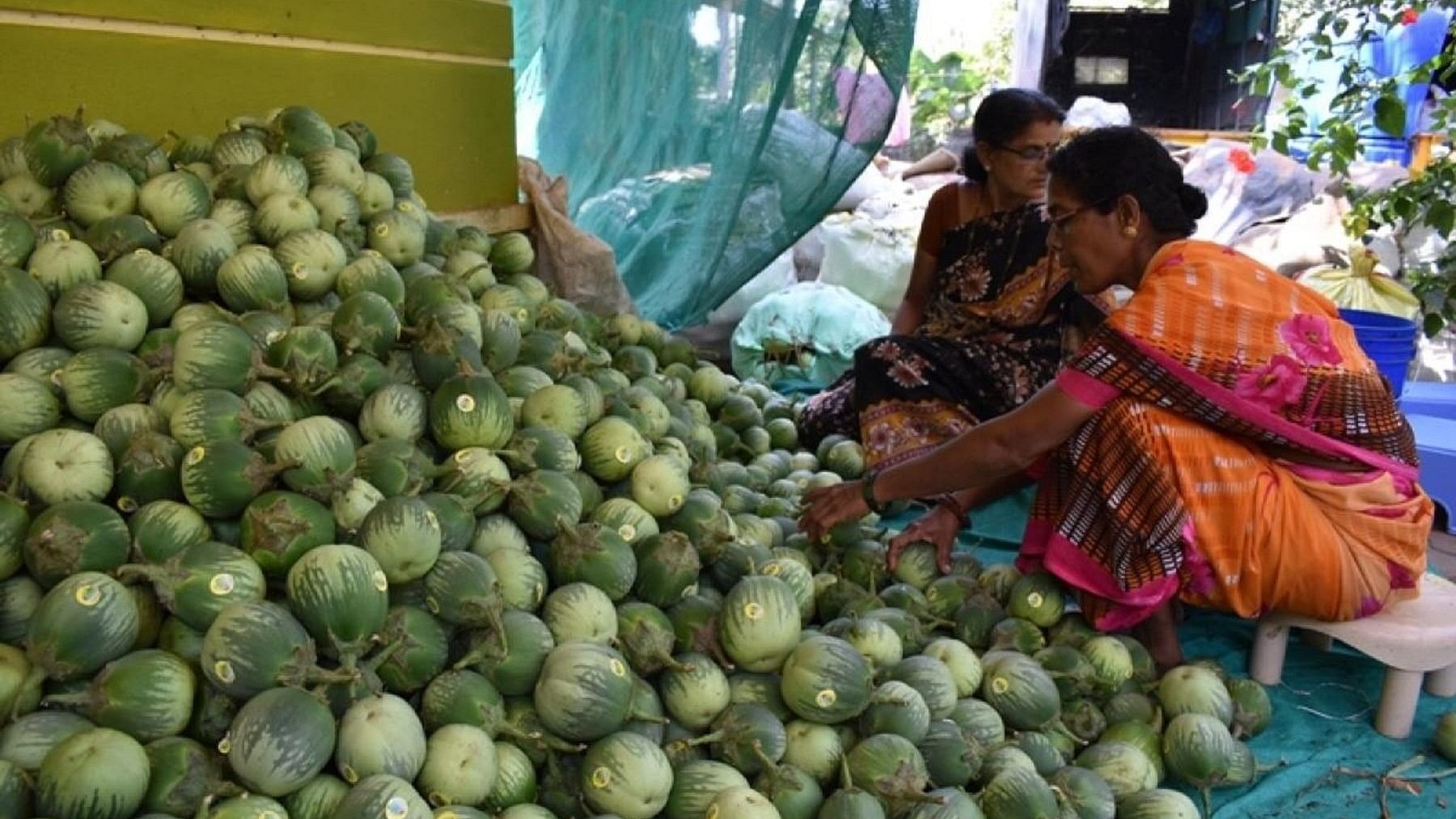
The ‘Mattu gulla’ variety of brinjal, which now has a GI tag.
Credit: DH File Photo
What did the people of Karunadu, now known as Karnataka, eat for breakfast, lunch and dinner? What did they serve at their feasts and festivals? The spectrum of choice was not as wide as it is today.
In medieval times, the food available was sufficient for nutrition and the sustenance of the people. The 16th-century poet Kanakadasa, in his Mohanatarangini, an ode to Krishna has described a typical lunch in an annachatra. The lunch consisted of rice, dal, a gravy prepared with buttermilk, rasam, soup and pickles. The sweet items consisted of pheni, sukkinunde, garige and mixed fruits with milk. After lunch, betel leaves with arecanut were commonly consumed.
In his 1978 book Namma Hotteyalli Dakshina America (South America in our Stomachs), botanist B G L Swamy discusses various foods, including pineapple, cashew, passion fruit, potato, papaya, guava and cassava. These crops, originally from South America, were introduced to Goa by the Portuguese and later cultivated in Karnataka. Many are now staples of Indian cuisine but trace their origins to countries like Brazil, Peru, Bolivia and Ecuador.
It was the pungent chilli which held the fancy of people, when it was first brought to Goa in 1511 from Malacca by Afonso de Albuquerque, the second Portuguese governor in India. From Goa, it came to the Vijayanagara capital, which had trade links to Europe and East Asia. People took an instant liking to it. Even Purandara Dasa composed an ode to the chilli (Vah vaah re mensinakai/ ona rottige tandenu taayi), which has been exquisitely rendered by singer Puttur Narasimha Nayak.
It is believed that Vadiraja Swamiji (1480-1600) of Sode mutt in Udupi, gave the seed of the brinjal to people of Mattu village, and asked them to grow it. Today, the ‘Mattu gulla’, a variety of brinjal, has earned a GI tag.
As for beverages, coffee came to Karnataka through the Sufi saint Baba Budan, who introduced the beans to the hills of Chikkamagaluru in 1670. It was later cultivated in Kodagu. In the past, jaggery was used to sweeten coffee.
The prosperity of the Vijayanagara kingdom extended to food, with rice, millets, corn, pulses, horsegram and many other cereals being easily and cheaply available.
Krishnadevaraya, who reigned from 1509-1529, composed Amuktamalyada, the Telugu epic poem which mentions that the dishes changed from season to season. The list of preparations in seasonal meals includes crispy black lentil chips, dried vegetable stir fry, jaggery-flavoured broths, sweet and savoury porridges, sweet cakes, tender mangoes and green vegetables flavoured with mustard powder. A seasoned mixture made with equal parts of cumin-spiced jaggery and tangy tamarind (similar to sambar) and a sweet and sour rice preparation is mentioned (tamarind rice or pulihora).
There were public eating houses in the capital city, where there were stone slabs with hollows in them for rice and curries. There were also many choultries that served food for free at the time.
According to Naren Thimmaiah, a Bengaluru-based chef, Karnataka’s cuisine has four distinct regional flavours — that of Mangaluru, Kodagu, Mysuru, and Dharwad (North Karnataka). “Just like the popular tagline of Karnataka — ‘One state, many worlds’ — regional cuisines also have many variations. There are many communities that follow their own traditions, which is what makes it different from the spicy food of Andhra Pradesh or the traditional food of Tamil Nadu.”
Food in the palaces Royalty of course enjoyed a comparatively richer cuisine but were not averse to the common people’s food. Kempegowda I and his descendants are thought to have relished avare kaalu with ragi mudde along with locally available greens. Huge stones used to grind ragi can be found in some of Kempegowda’s forts ostensibly for the use of his soldiers. Yusuf Adil Shah the Sultan of Bijapur is recorded by historians to have enjoyed xacuti a spiced stew of chicken or mutton with ingredients like pepper coconut and tamarind from the Konkan coast. He may have paired it with sol kadhi a pink coconut milk drink flavoured with kokum.
Thanks to his Marathi wife Satti Bai he was also exposed to western Indian cuisine featuring tamarind jaggery and curry leaves common to the Konkan and Karavali regions known for rice coconut and local vegetables. Lt Col Alexander Beatson notes that Tipu Sultan’s breakfast included nuts almonds fruit jelly (possibly kheer or upma) and milk. During breakfast Tipu discussed business and administration with advisors like Mir Sadiq and Purnaiah while dictating letters. He also enjoyed boneless lamb marinated in spiced yogurt likely sourced from Bannur sheep and king prawns from the coastal region both cooked over a charcoal grill. When it comes to sweets the prasada called ‘hayagreeva’ which also doubles as a sweet served in Udupi restaurants is attributed to Vadiraja. It is made with Bengal gram jaggery ghee and grated coconut.
The quintessential food item from Karnataka is undoubtedly the idli. A form of idli known as ‘iddalage’ is mentioned in Vaddaradhane a 9th-century work in Kannada by Shivakotiacharya possibly a native of Kogali in Ballari district. In 1025 a poet named Chavundaraya writing the Lokopakara a Kannada guidebook also explains the process of making iddalage. Manasollasa a Sanskrit work written by the Western Chalukya king Someshara III (1126 – 1138 CE) mentions a recipe for ‘iddarika’ that is similar to idli. It is made from urad dal flour and buttermilk. From thatte idlis to mallige idlis and from Mangalorean sannas to Malnad kottige steamed in leaves idlis have come a long way.